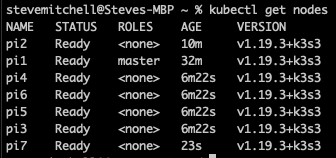How to Install Rancher Labs k3s on Raspbian or Ubuntu

Add Cgroups to Linux
Before jumping into Kubernetes, Linux needs to be setup for virtualization.
Containers and virtual machines rely on Linux namespaces and control groups for security, so we need to enable them in Raspbian by editing the /boot/cmdline.txt file. Reboot the nodes when you finish.
Enable Virtualization for Raspbian
1
2
3
4
sudo cp /boot/cmdline.txt /boot/cmdline.txt.bak1
orig="$(head -n1 /boot/cmdline.txt) cgroup_enable=cpuset cgroup_memory=1 cgroup_enable=memory"
echo $orig | sudo tee /boot/cmdline.txt
sudo reboot
Enable Virtualization for Ubuntu
1
2
3
4
sudo cp /boot/firmware/cmdline.txt /boot/firmware/cmdline.txt.bak1
orig="$(head -n1 /boot/firmware/cmdline.txt) cgroup_enable=cpuset cgroup_memory=1 cgroup_enable=memory"
echo $orig | sudo tee /boot/firmware/cmdline.txt
sudo reboot
Installing the Master Node
It is straightforward to get started with K3s. See the Quick Start Guide. I installed k3s slightly differently using the command below. It downloads an installation script, pipes it into the shell to install and configure the master node, and then starts the server. The Kubeconfig config is stored in /etc/rancher/k3s/k3s.yaml during the process.
1
curl -sfL https://get.k3s.io | sh -s - server &
When the server starts, verify the installation with this command:
1
2
3
$ sudo k3s kubectl get nodes
NAME STATUS ROLES AGE VERSION
pi1 Ready master 3m15s v1.19.3+k3s3
Next, copy the kubeconfig file and change the server IP address from 127.0.0.1 to the master node IP address. You will use this copy of the kubeconfig file to access k3s from your computer.
1
2
sudo cp /etc/rancher/k3s/k3s.yaml ~/kubeconfig
sudo chown $(whoami):$(whoami) ~/kubeconfig
Copy the edited file to your computer. Export the KUBECONFIG variable from the shell or export it from your ~/.zshrc or ~/.bashrc file.
1
2
scp pi@pi1:~/kubeconfig ~/kubeconfig
export KUBECONFIG=~/kubeconfig
Verify that your laptop or desktop computer is configured correctly by getting a list of the nodes:
1
2
3
$ kubectl get nodes
NAME STATUS ROLES AGE VERSION
pi1 Ready master 3m15s v1.19.3+k3s3
Installing the Agent Nodes
List the server token from the master node, copy it, and save it for later.
1
2
ssh pi@pi1
sudo cat /var/lib/rancher/k3s/server/node-token
Pass the server token into the agent node command to install the k3s agent on the remaining Raspberry Pis in your cluster. You can do this on the nodes individually or use the tip below to install the agent on all of the nodes simultaneously.
Whether you update the nodes one at a time or simultaneously, export the server token copied above as a variable, and then run the command shown. When I installed Ubuntu, I broadcast the commands to all the worker nodes at the same time and it worked great.
1
2
3
ssh pi2
export TOKEN=***REDACTED***
curl -sfL https://get.k3s.io agent | INSTALL_K3S_EXEC="agent --server https://192.168.1.10:6443 --token $TOKEN" sh -
Wait a couple of minutes while the agent starts-up and registers with the main node. Re-run “kubectl get nodes.” You should see results like those shown below.

References
- Rancher Docs: Quick-Start Guide
- Building a kubernetes cluster on Raspberry Pi and low-end equipment. Part 1
- k3s on Raspberry Pi
- Cheap and local Kubernetes playground with K3s & Helm
- Will it cluster? k3s on your Raspberry Pi
- Building a kubernetes cluster on Raspberry Pi and low-end equipment. Part 1
- Kubernetes (K3S) on a RaspberryPi